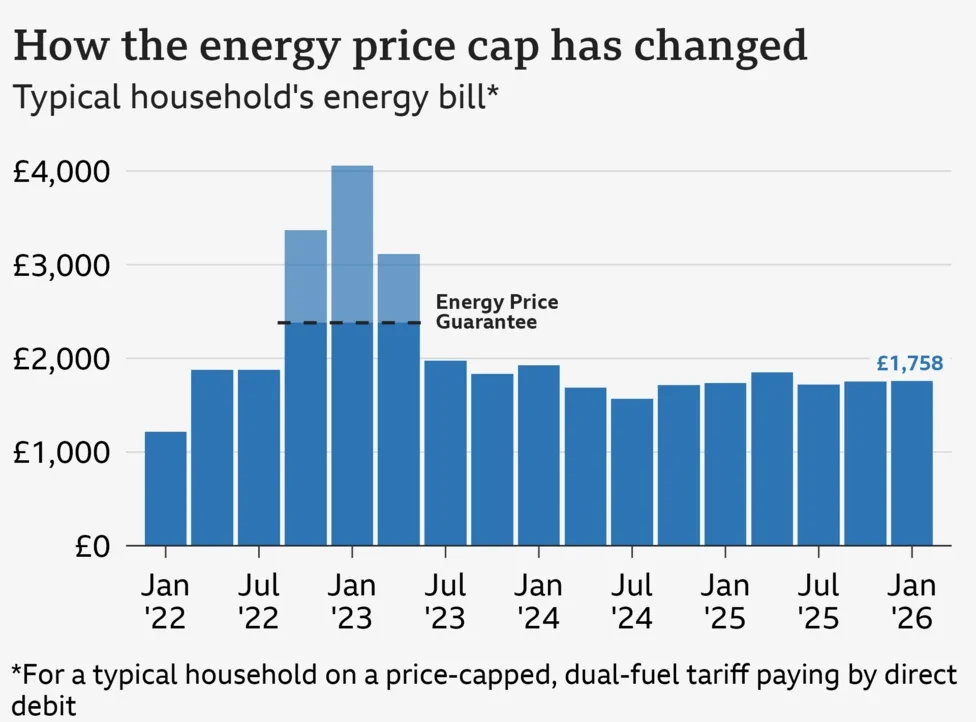Millions of UK households woke up this morning to stark reality from Ofgem. The energy regulator confirmed a 0.2% rise in the price cap starting January 2025. This tweak hits variable tariff users across England, Wales, and Scotland right as winter bites harder. Even a tiny shift like this packs a punch for families already stretched thin by soaring costs.
For the average home using 11,500 kWh of gas and 2,700 kWh of electricity each year, bills climb from £1,755 to £1,758 annually. That adds just £3 over 12 months, or about 28p monthly. Yet bigger homes or those leaning heavy on electricity face steeper jumps. Unit rates for power nudge up while gas dips slightly, tipping the balance against users who rely more on plugs than pipes.
Why Energy Prices Are Rising
Ofgem dropped this bombshell today, pinning the uptick not on wild wholesale swings but on quieter culprits. Stabilizing fuel markets offer some breathing room, yet government mandates and network upkeep push costs higher. Funding for the Sizewell C nuclear build and other green shifts eat into budgets, alongside climbing standing charges that cover grid maintenance and levies.
Electricity standing charges jump 2%, gas by 3%, hitting every bill regardless of usage. Tim Jarvis at Ofgem put it plainly during today's briefing. Wholesale prices dominate bills still, he said, exposing families to ups and downs that feel all too familiar. According to analysis reviewed by Finance Monthly, these policy-driven hikes signal a pattern as the UK races toward net-zero goals.
Experts at Cornwall Insight echo the worry, forecasting that non-fuel factors could fuel even larger increases by spring. Dr Craig Lowrey, their principal consultant, warns this dip in wholesale relief gets overshadowed by infrastructure bills landing squarely on consumers. It's a tough pill when temperatures plummet and wallets tighten.

The latest Ofgem chart shows how the energy price cap will increase slightly at the start of 2025, affecting households on variable tariffs and highlighting the financial pressure of winter energy costs.
Who Will Be Hit the Hardest
Low-income families and electric-heavy homes bear the brunt of this quiet escalation. Those on variable deals lack buffers, watching monthly outgoings creep up amid peak heating season. Charities track a grim milestone with £4.4 billion in unpaid supplier debts, the highest ever recorded. Ofgem eyes forgiving up to £500 million of that load come early 2026, a lifeline for the most vulnerable.
Dame Clare Moriarty from Citizens Advice captured the raw edge of it all. Bills hover far above pre-crisis norms, she noted, forcing impossible choices on warmth versus other essentials. With April's cap potentially swelling another 4-5%, the squeeze turns chronic for renters in drafty flats or parents juggling remote work setups.
Decoding Policy Costs: The Silent Tax Padding Your Winter Bills
Policy costs sound dry, but they act like a hidden surcharge on every kWh you flip on. These are mandatory add-ons to bills that fund big-picture shifts, from subsidizing renewable farms to bolstering nuclear plants like Sizewell C. Unlike volatile gas prices, they stem from deliberate government choices, baked into regulations that suppliers pass straight to you.
Think of them as the entry fee for a greener grid, covering everything from Warm Home Discount payouts to wiring upgrades for electric cars. Right now, they claim about 25% of a typical dual-fuel bill, up from 20% just two years ago, per Ofgem data. For a medium-use household, that's an extra £20 monthly from these alone, not the headline wholesale drama.
Martin Lewis, the sharp-eyed founder of MoneySavingExpert, cuts through the fog with frustration that resonates. The rise isn't from pricier fuel, he explained today, but a cocktail of policy and network hits, including nuclear levies that ironically hike electricity just as we push away from gas. It's perverse, he added, loading costs onto the clean energy we need most.
This angle reveals a deeper truth for your finances: short-term pain buys long-term armor against oil shocks. Yet without tweaks, like spreading costs over decades via bonds, families foot the bill unevenly. One anonymized example from recent audits shows a pensioner in the Midlands whose £120 monthly bill swelled 15% from policy alone last year, forcing skipped meals. The insight? Track your breakdown via supplier statements, then lobby for fairer allocation, it could shave £50-100 yearly through targeted rebates.

Simple actions, like adjusting your radiator, can help households manage rising energy costs amid the 2025 price cap increase, easing the financial burden this winter.
Government Support and Practical Steps to Ease the Sting
The government signals more aid in the December budget, eyeing VAT scraps on energy that might save £80 per household yearly. Energy Minister Martin McCluskey touted an expanded Warm Home Discount today, dishing £150 rebates to millions facing the chill. Shadow voices like Claire Coutinho push back, claiming net-zero zeal risks locking in high costs despite easing gas markets.
You can counterpunch with smart moves that stick. Heat only rooms in use to trim 10-15% off gas tabs. Layer up with thermals and throws before cranking the thermostat. Seal drafts around doors and windows, a quick fix yielding 5-10% savings per Ofgem estimates. Hunt fixed tariffs now, some 10% below cap levels, to shield against April's forecast climb.
In the end, this 0.2% whisper from Ofgem today underscores a louder roar of financial grit. UK homes navigate debt swells, green gambles, and seasonal demands with resolve that borders on heroic. Small rises compound into real hardships, urging sharper budgets and bolder calls for equitable energy futures. Stay vigilant, it might just warm your home and lighten the load.
What Readers Like You Are Asking Right Now
How much will my energy bill actually go up in January 2025 if I use more electricity?
The 0.2% cap hike masks uneven hits, especially for electric-dependent homes. Ofgem's tweak lifts electricity units by about 1.2p per kWh while gas eases 0.6p, so high-power users like EV owners or all-electric setups could see 3-4% jumps, or £5-10 extra monthly. Martin Lewis flags this as the real story, urging switches to fixed deals now for stability through spring. Check your usage via your app to gauge the personal toll accurately.
Are there any new government schemes to help with rising energy costs this winter?
Yes, today's announcements spotlight the beefed-up Warm Home Discount, auto-applying £150 to eligible low-income bills from October to March. Budget whispers hint at VAT cuts too, potentially trimming £80 yearly across the board. Ofgem's debt forgiveness plan targets £500 million in arrears next year, prioritizing vulnerable spots. Apply via suppliers if needed, these buffers could cover a full month's standing charge for many families scraping by.
Will energy prices keep rising throughout 2025, and how can I prepare financially?
Forecasts point to a 4-5% cap swell by April 2026 from network builds, though summer might ease with renewables ramping up. Cornwall Insight sees policy costs as the steady driver, not fuel whims. Build a buffer by auditing leaks, grabbing rebates, and locking cheap fixes, saving up to £200 yearly per household. Track via tools like Cheap Energy Club, turning dread into dollars back in your pocket for tougher months ahead.














